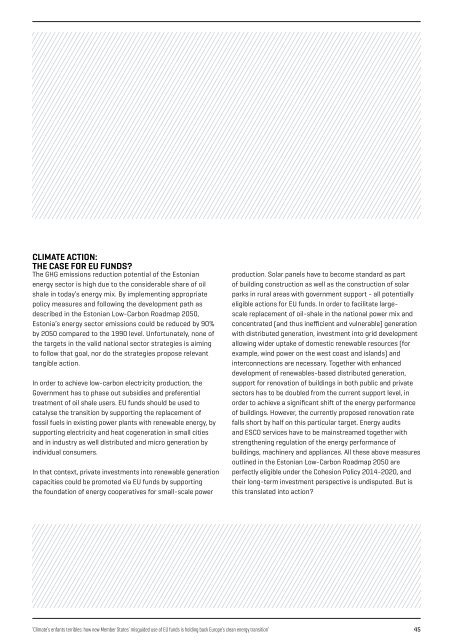ENFANTS TERRIBLES
enfants-terribles
enfants-terribles
You also want an ePaper? Increase the reach of your titles
YUMPU automatically turns print PDFs into web optimized ePapers that Google loves.
CLIMATE ACTION:<br />
THE CASE FOR EU FUNDS?<br />
The GHG emissions reduction potential of the Estonian<br />
energy sector is high due to the considerable share of oil<br />
shale in today’s energy mix. By implementing appropriate<br />
policy measures and following the development path as<br />
described in the Estonian Low-Carbon Roadmap 2050,<br />
Estonia’s energy sector emissions could be reduced by 90%<br />
by 2050 compared to the 1990 level. Unfortunately, none of<br />
the targets in the valid national sector strategies is aiming<br />
to follow that goal, nor do the strategies propose relevant<br />
tangible action.<br />
In order to achieve low-carbon electricity production, the<br />
Government has to phase out subsidies and preferential<br />
treatment of oil shale users. EU funds should be used to<br />
catalyse the transition by supporting the replacement of<br />
fossil fuels in existing power plants with renewable energy, by<br />
supporting electricity and heat cogeneration in small cities<br />
and in industry as well distributed and micro generation by<br />
individual consumers.<br />
In that context, private investments into renewable generation<br />
capacities could be promoted via EU funds by supporting<br />
the foundation of energy cooperatives for small-scale power<br />
production. Solar panels have to become standard as part<br />
of building construction as well as the construction of solar<br />
parks in rural areas with government support - all potentially<br />
eligible actions for EU funds. In order to facilitate largescale<br />
replacement of oil-shale in the national power mix and<br />
concentrated (and thus inefficient and vulnerable) generation<br />
with distributed generation, investment into grid development<br />
allowing wider uptake of domestic renewable resources (for<br />
example, wind power on the west coast and islands) and<br />
interconnections are necessary. Together with enhanced<br />
development of renewables-based distributed generation,<br />
support for renovation of buildings in both public and private<br />
sectors has to be doubled from the current support level, in<br />
order to achieve a significant shift of the energy performance<br />
of buildings. However, the currently proposed renovation rate<br />
falls short by half on this particular target. Energy audits<br />
and ESCO services have to be mainstreamed together with<br />
strengthening regulation of the energy performance of<br />
buildings, machinery and appliances. All these above measures<br />
outlined in the Estonian Low-Carbon Roadmap 2050 are<br />
perfectly eligible under the Cohesion Policy 2014-2020, and<br />
their long-term investment perspective is undisputed. But is<br />
this translated into action?<br />
‘Climate’s enfants terribles: how new Member States’ misguided use of EU funds is holding back Europe’s clean energy transition’ 45


